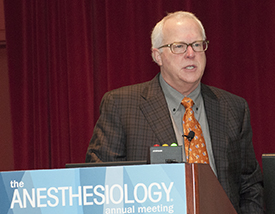
Douglas G. Merrill, M.D., M.B.A.
The U.S. has the highest cost of health care in the world, and government and industry have long struggled to find ways to improve efficiency. One option gaining attention is the adoption of lean principles started by auto manufacturers in Japan. A Sunday session, “Kaizen! Employing Lean Principles in the Ambulatory Setting,” looked at the potential of lean.
“Lean is a proven methodology that reduces waste and improves productivity in a repeatable process,” said Douglas G. Merrill, M.D., M.B.A. “The ASC or HOPD is defined by repeatable processes and a strategy of efficiency and high productivity, which is the very definition of potential for high value.
“It is the same surgeons doing the same surgeries over and over again. You should be able to use lean management to get better at that.”
The key word in lean principles is “kaizen,” which means continuous improvement. Lean has been called the Toyota production system, as it was developed by Japanese automakers to improve efficiency in the 1950s and 1960s when they had to produce a greater variety of car models in lower volumes compared to U.S. manufacturers.
The lean processes were so successful that a great number of manufacturers around the world — including the U.S. — have adopted them to reduce operating costs.
“We need to get our costs down and be more efficient,” said Dr. Merrill, Chief Medical Officer, University of California, Irvine Medical Center, and Senior Associate Dean for Quality and Patient Safety at the University of California, Irvine School of Medicine. “Variation is a significant driver of cost.”
As an example, the average cost of a total knee replacement procedure is $31,124 in 64 markets, with costs ranging from $11,317 in Montgomery, Alabama, to $69,654 in New York. Within Dallas, the cost varies from $16,772 to $61,585.
Inefficiencies in such elective procedures are common. A 2015 study found that in some cases, up to 25 percent of elective surgeries are canceled, and 41 percent of the time that is due to unavailability of providers or to O.R. timing.
Dr. Merrill reviewed the lean process, which has found that the “seven wastes” in manufacturing as applied to health care are:
- Transportation: Keeping often-used materials at a distant site where staff must walk to get them
- Inventory: Patients waiting to be discharged
- Motion: Keeping rarely used instruments on the mayo stand
- Waiting (Delay): Patients waiting to be checked in or surgeons waiting for patients to come to the O.R.
- Overproduction: Keeping block time open until no one else can use it
- Over-processing: Nurse anesthetists repeating an anesthesiologist’s health and physical interview 15 minutes afterward
- Defects and Corrections: Case cancellations
Lean is the application of a scientific method to a measurable entity. It starts with a kaizen event, which is a review of the processes that involves all stakeholders. In most hospitals, this should take only one or two days, Dr. Merrill said, adding, “Make sure they understand what’s in it for them.”
The six steps of kaizen are:
- Define the problem and the goals
- Analyze the data
- Generate potential solutions
- Plan and get approval
- Implement
- Measure and ensure sustainability
Dr. Merrill walked through the kaizen process and how the process changes are best implemented — as quickly as possible after the kaizen. It is best to implement only about five changes at a time.
“Lean and kaizen will fail if it is a top-down strategy. Management doesn’t change culture. Management invites the workforce itself to change the culture,” he said. “Ask them for their thoughts on potential projects. Invite their aid to plan the scope of the chosen project.”
Return to Archive Index